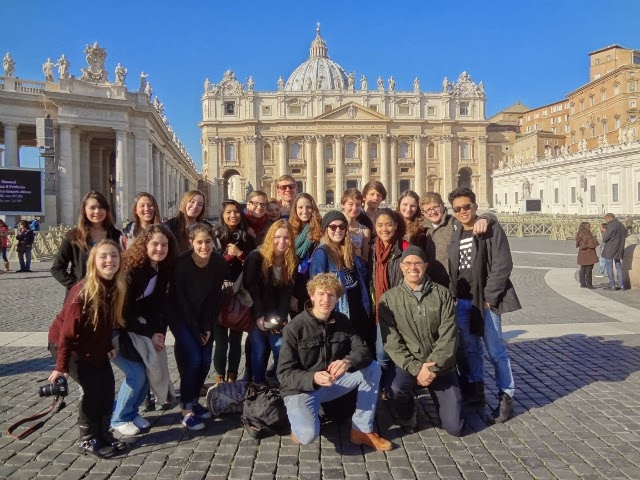Today we embarked on the fourth and final trip to
Rome. Over four trips, students were
exposed to the Coluseum-Palentine-Roman Forum (led by Santo Sammartino), Rome
as a movie set (led by Daniele Gatti), the Catacombs of Sant’ Agnese-Tomb of Santa
Costanza-Crypt of the Cappucini Monks (led by Brad Park) and lastly (but certainly
not leastly) Il Vaticano (led by Yvonne Mazurek). All of the trips were great but I was
really looking forward to Yvonne leading us through the Vatican Museum and the
Basilica of St. Peter. Her knowledge of
the Vatican Museum, in particular, was immense.
In this picture, Yvonne is discussing this
altarpiece, a triptych by Giotto, featuring St. Peter (on throne with the two
keys) surrounded by four other saints, including Andrew, John, James the Elder and Paul. Part of our tour of the Vatican Museum included a
long room called the Hall of Maps, a room full of maps of different regions of
Italy, all tapestries stitched in the 16th century. Here’s a
tapestry of the province of Lazio. In
the lower left-hand corner is an insert of the medieval part of Viterbo, the
capital of the region (within Lazio) also known as Viterbo. Most of the tapestries do not have this
insert but Viterbo has this honor because of its connection to housing the
papacy during the 13th century.
Part of our tour of the Vatican Museum included a
long room called the Hall of Maps, a room full of maps of different regions of
Italy, all tapestries stitched in the 16th century. Here’s a
tapestry of the province of Lazio. In
the lower left-hand corner is an insert of the medieval part of Viterbo, the
capital of the region (within Lazio) also known as Viterbo. Most of the tapestries do not have this
insert but Viterbo has this honor because of its connection to housing the
papacy during the 13th century.
Next, we entered the Pinectoteca, a.k.a. the
painting gallery. Here’s a painting of the
transfiguration of Jesus Christ (Rafaello and Giulio Romano). This was Rafaello’s very last painting before
his death. In fact, he did not finish it
so Romano, his apprentice, did. The
bottom half is Romano’s “response to his master’s section,” as Yvonne put
it. She used the word, “response”, to
illustrate the contrast in styles between Rafaello and Romano.
 Here's is a painting of St. Peter being crucified upside down (by Guido Reni). While a disciple of Jesus Christ, Peter didn't see himself worthy of being crucified in the same manner as his teacher. So as a last request, he asked to be turned upside down on the cross.
Here's is a painting of St. Peter being crucified upside down (by Guido Reni). While a disciple of Jesus Christ, Peter didn't see himself worthy of being crucified in the same manner as his teacher. So as a last request, he asked to be turned upside down on the cross.
Next, it was off to the Sistine Chapel. Fortunately it was a sunny day, as the chapel
is naturally lit to help preserve Michelangelo’s masterpiece on its
ceiling. Because we went on a Thursday
in early February, the crowds were not huge.
This was especially noticeable in the Sistine Chapel. People, in general, were very cooperative and
respectful of the space and actually did little speaking while in there. Yvonne and I actually were able to find seats
along the wall in the sanctuary.
.jpg) Lastly, we were led to the Basilica of St. Peter, an
enormous church that could overwhelm anyone but I found a serenity come over me
as I entered it. The Pietá, on the right as you enter from the back, is an
obvious attraction for many tourists and for good reason. Michelangelo is a master at capturing the
essence of Mary’s final moments with Jesus upon his dissention from the cross.
Lastly, we were led to the Basilica of St. Peter, an
enormous church that could overwhelm anyone but I found a serenity come over me
as I entered it. The Pietá, on the right as you enter from the back, is an
obvious attraction for many tourists and for good reason. Michelangelo is a master at capturing the
essence of Mary’s final moments with Jesus upon his dissention from the cross.Also in the back of the church are St. Peter's silver and gold keys to the Kingdom (above right), which were given to him by Jesus Christ. One of the keys opens the gates of Heaven while the other key represents terrestrial power, as stated in Matthew 16:19. "Whatever you bind on earth shall be bound in Heaven, and whatever you loose on earth shall be loosed in Heaven." It's a metaphorical offering of Jesus Christ to St. Peter that he has in his care the teachings of God and, in essence, the care of the Church in his hands. The keys are then to be passed down to each descendant of the papacy thereafter. Upon the death of a Pope, a symbolic set of these keys is buried with him, a tradition began back in the 16th century.
 |
| Front: Aiden and Me Middle: Corynne, Marlaina, Emma, Liddy, Rhyan, Rachel, Nick and Akbar Back: Arielle, Casey, Siena, Thea, Yvonne, Savannah (Brad's daughter), Brad, Victoria, Izzy, Ethan and Quincy |
.jpg)



No comments:
Post a Comment